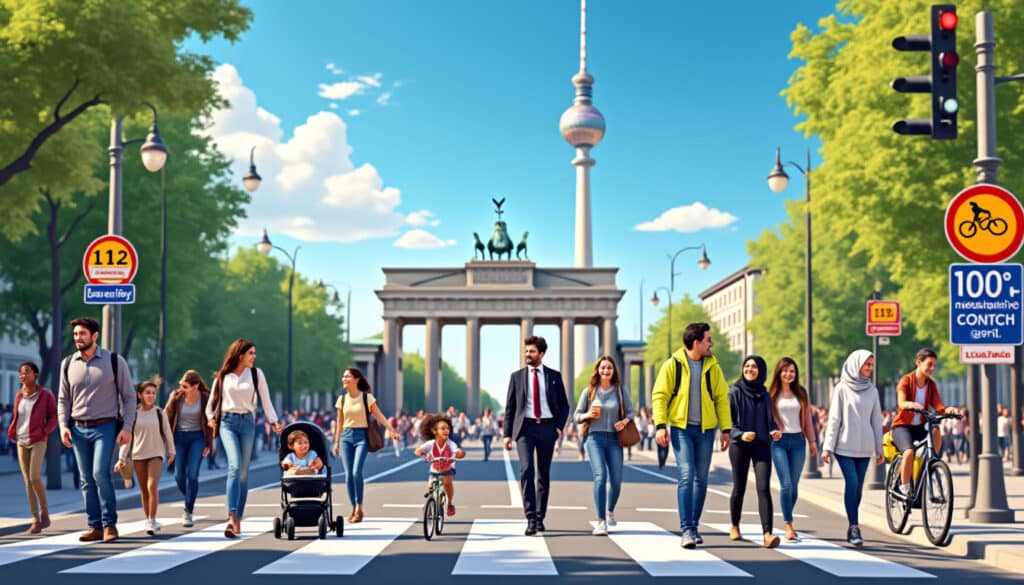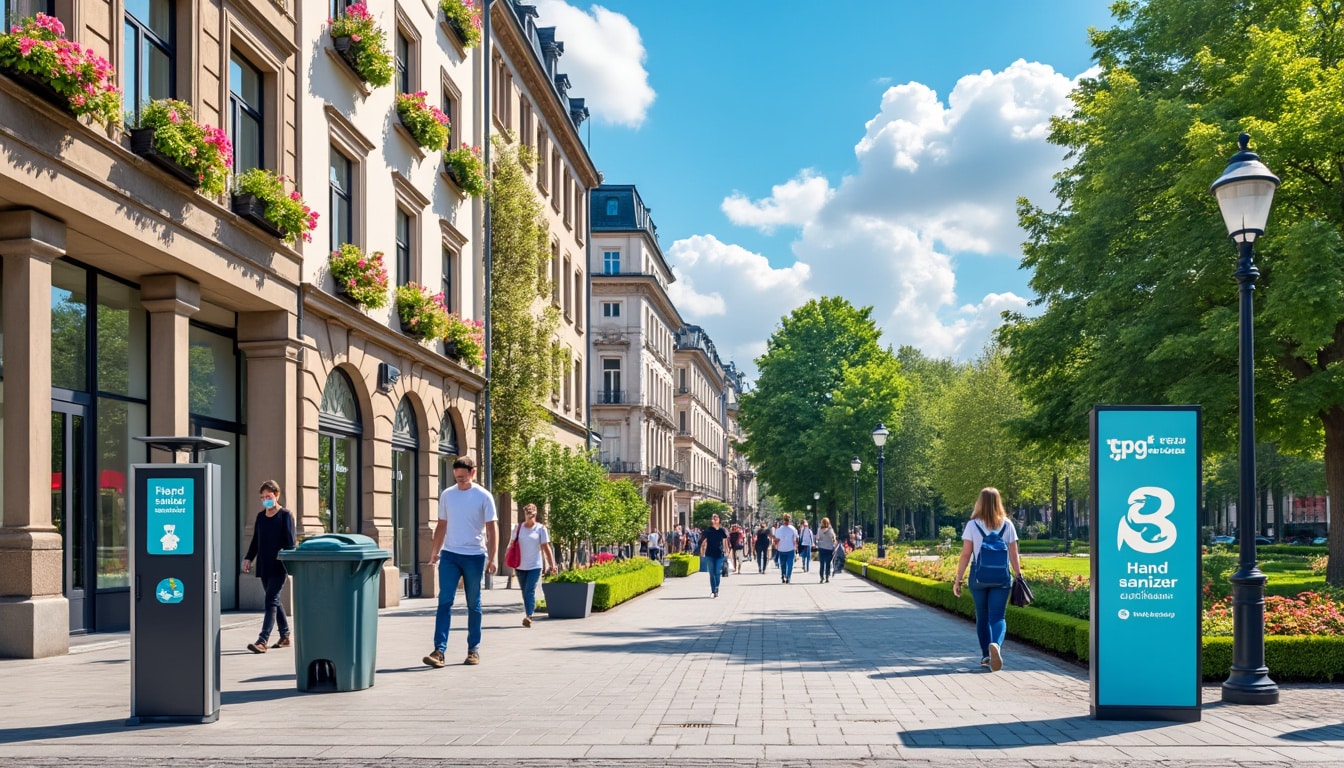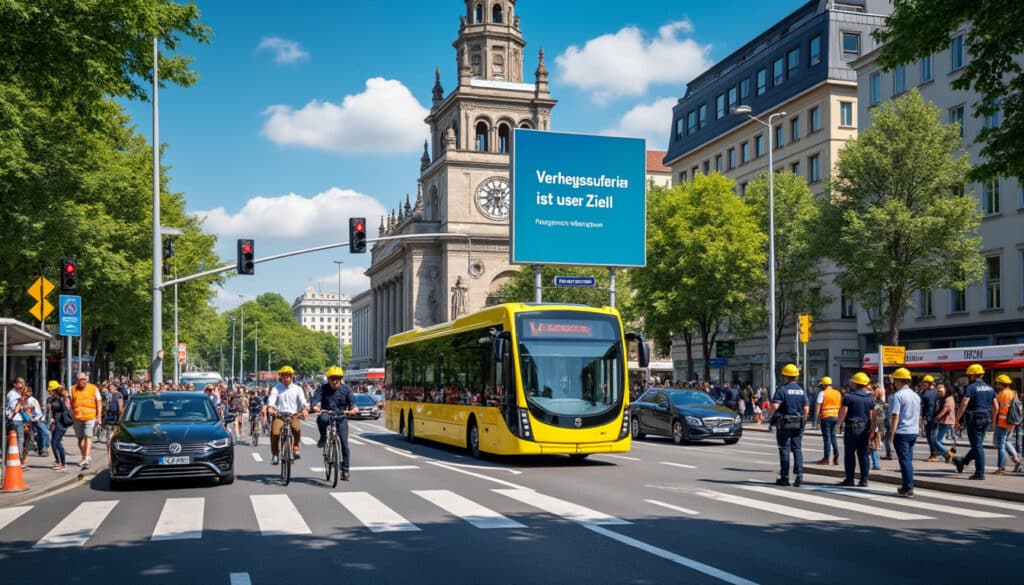Berlin, a city known for its vibrant culture and dynamic lifestyle, places a significant emphasis on cleanliness and hygiene as the cornerstone of public well-being. With rapid urban development, maintaining a pristine environment in Berlin is more crucial than ever. This article delves into the city’s initiatives, regulations, and cultural attitudes toward cleanliness, offering insights into the ongoing efforts to keep the city clean and inviting for both residents and visitors.
Berlin’s Approach to Urban Cleanliness: Strategies and Solutions
In the vibrant metropolis of Berlin, ensuring urban cleanliness is not just a matter of aesthetics but a public necessity. The city’s government employs a comprehensive array of strategies to maintain cleanliness effectively. From regular street cleaning to waste management programs, Berlin prioritizes a systematized approach to tackle urban grime and litter.

At the heart of Berlin’s cleanliness strategy is the Berlin City Cleaning (BSR), an organization pivotal in executing the city’s waste management policies. BSR orchestrates a meticulous schedule involving daily cleaning operations. They take charge of maintaining streets, sidewalks, and public squares, ensuring cleanliness even in the city’s most bustling areas.
Moreover, Berlin’s attention to future sustainability is exemplified through its integration of eco-friendly vehicles—a move that not only aids in maintaining the city’s cleanliness but also in reducing carbon emissions. Simultaneously, the “Tiptapp” app is pivotal. It enables citizens to report illegal waste, making waste management collaborative with civic participation.
The Role of Waste Segregation
Waste segregation plays a critical role in maintaining Berlin’s cleanliness. The city enforces stringent rules on waste separation, aiding effective recycling processes. Incorporating waste segregation not only enhances recycling efforts but underscores environmental consciousness.
- ♻️ Strict rules on separating recyclables from general waste.
- 🚮 Implementation of numerous recycling bins across the city.
- 🌿 Set up of organic waste collection points to streamline composting.
The presence of companies like Henkel, with their innovation in detergents, highlights a collaboration between private enterprises and the city in promoting sustainability. Such partnerships foster a culture that values cleanliness while pushing forward sustainable solutions.
Collaborative Citizen Efforts
Berlin has initiated campaigns encouraging citizen participation in cleanliness drives. These endeavors underline the importance of civic engagement in upholding urban hygiene, shaping a community-driven approach to cleanliness.
Citizens are further motivated through distinctive behavioral nudges like community clean-up events and education drives that foster a shared responsibility. Berlin exemplifies how engaged communities can significantly influence public spaces, ensuring the city maintains its allure and sanitation standards.
| Initiative | Description | Impact |
|---|---|---|
| Regular Street Cleaning | BSR daily cleaning operations | Maintained cleanliness in urban areas |
| Waste Segregation | Recycling and composting efforts | Enhanced recycling efficacy |
| Collaborative Efforts | Citizen awareness programs | Increased public participation |
The Clean Kitchen Act: A New Era in Culinary Hygiene
The introduction of the Clean Kitchen Act marked a significant shift in Berlin’s regulatory framework concerning culinary hygiene. Effective since 2023, this act mandates all culinary establishments to undergo health and hygiene assessments whose results must be visibly displayed to the public.
This initiative drives transparency by allowing consumers to make informed choices about where to dine, enhancing not only their dining experience but their health and safety. Modeled after the Danish ‘Smile’ system, Berlin adopts a progressive approach, presenting results in a user-friendly bar chart format with gradations from green (excellent) to red (poor).
Despite its benefits, the Clean Kitchen Act has faced criticism, particularly regarding its perceived leniency. Establishments that receive unfavorable assessments have the option to request follow-up evaluations—a provision seen by some critics as an opportunity for venues to “buy” a better rating. However, it still stands as a revolutionary step in promoting accountability within the culinary sector.
Transparency in Dining
The Berlin Senate’s push for transparency in dining establishments leads the way in modern consumer protection. With mandatory transparency barometers displayed at restaurant entrances, diners have access to critical information about a restaurant’s hygiene practices. This empowers them, fundamentally shifting the power dynamics in the food industry.
Transparency not only drives consumer awareness but also nudges establishments toward improving their hygiene standards. It incentivizes them to maintain high standards consistently, affecting the overall dining culture positively.
Restaurants like Procter & Gamble, Unilever, and cafes utilizing food service solutions from Sodexo and Diversey, have adapted their practices to align with these new standards, showing the practical success and influence of such policies.
- 🔍 Consumer empowerment through visible hygiene ratings.
- 🍽️ Greater accountability among culinary businesses.
- 🏅 Incentives for maintaining higher sanitary standards.
Challenges and Future Prospects
While the Clean Kitchen Act lays a robust foundation for hygiene in Berlin’s gastronomy sector, it continually faces challenges. Balancing transparency with fairness to business owners is a delicate maneuver. Ensuring that follow-up assessments reflect true improvements rather than strategic re-scheduling is imperative.
In the long run, more stringent checks coupled with continuous updates to the policy can potentially address these shortcomings. Berlin’s approach, when refined, could serve as a model for other global cities aiming for higher standards in public health and safety.
| Feature | Description |
|---|---|
| Transparency Barometer | Colour gradient charts showing hygiene status |
| Consumer Empowerment | Visible ratings allow for informed dining decisions |
| Challenges | Ensuring fairness and accuracy in follow-up assessments |
Off the Beaten Path: Cleaning Habits in Berlin’s Households
Beyond public spaces, Berliners hold cleanliness and hygiene in high regard within their households, an aspect often reflected in cultural norms across Germany. Known for their methodical precision, typical German household cleaning regimes stand as a testament to thoroughness and efficiency.
Households in Berlin embrace advanced technology and eco-friendly products to elevate home hygiene standards. Brands like BASF, Ecover, and Wärtsilä contribute significantly, offering innovative cleaning solutions suited to modern needs. Their presence in the market not only highlights the emphasis on household hygiene but promotes environmentally sustainable practices.
Tools of the Trade
Technological innovation is a feature of the Berlin cleaning landscape. Robotic vacuum cleaners, steam mops, and eco-friendly cleaning agents are commonplace. These tools enhance effectiveness while minimizing environmental impact.
- 🤖 Robotic vacuum cleaners for efficient dust removal.
- 🏠 Steam mops for spotless kitchen and bathroom cleaning.
- 🌱 Organic cleaning agents reducing chemical exposure.
These advancements underscore a broader shift towards sustainable living, with urban households leveraging technology and eco-friendly products to maintain cleanliness without compromising on their environmental responsibility.
Cultural Significance of Hygiene
Hygiene in Berlin extends past physical cleaning, tapping into cultural values emphasizing order and discipline. The emphasis on a tidy living space resonates deeply with traditional German culture. Households undertake regular deep cleaning tasks and adhere strictly to routines, with a particular focus on avoiding clutter and ensuring hygiene in food preparation areas.
This cultural disposition towards cleanliness transcends generations, often inculcated from a young age. It points to a collective understanding of the positive impact a clean environment has on mental well-being, aligning with contemporary studies linking organized spaces to reduced stress levels.
| Feature | Impact |
|---|---|
| Advanced Cleaning Tools | Enhanced efficiency, eco-friendly |
| Cultural Traditions | Emphasis on order and hygiene |
| Mental Well-being | Correlation between cleanliness and reduced stress |
Public Transport: Keeping Berlin’s Commuter Experience Clean
Public transport is an essential part of Berlin’s ecosystem, with millions relying on it for daily commutes. Maintaining cleanliness within this network is crucial for both health and comfort. The BVG (Berliner Verkehrsbetriebe), Berlin’s primary public transit operator, plays an instrumental role in this regard.
The Role of Disinfection Protocols
In response to sanitation concerns, particularly during health crises, BVG adopts rigorous disinfection protocols. Priority areas include high-contact surfaces like door handles, seats, and ticket machines. These measures ensure commuter safety, underscoring the importance of hygiene in public transport.
- 🧼 Regular cleaning of high-contact surfaces.
- 🚍 Enhanced disinfection protocols during peak hours.
- 🚇 Strategic deployment of cleaning staff in transit hubs.
Such protocols not only protect physical health but contribute to a calm commuting experience, increasing public confidence in using shared services extensively.
Public Responsibility and Participation
Berlin places significant emphasis on public responsibility in maintaining the cleanliness of its transportation system. Announcements remind passengers of their role in this communal effort, encouraging responsible behavior such as proper disposal of waste and adherence to conduct codes.
Technological solutions also find their place in maintaining transport cleanliness. Feedback mechanisms allow passengers to report cleanliness issues directly via mobile applications, enabling timely responses and fortifying the collaborative effort between public services and commuters.
Companies like Sealed Air and M have contributed solutions that ensure the maintenance of high hygiene standards, facilitating a seamless integration between public initiatives and technological advancements in sanitation.
| Initiative | Description | Impact |
|---|---|---|
| Disinfection Measures | Regular and thorough cleaning protocols | Increased commuter confidence |
| Public Announcements | Encouragement of responsible behavior | Improved communal effort |
| Feedback Mechanisms | Direct reporting via applications | Timely responsiveness to issues |
Future Prospects and Innovations in Berlin’s Hygiene Standards
As Berlin continues its growth, its aspirations to uphold high cleanliness and hygiene standards never wavers. Adopting a future-focused vision, the city seeks innovation in sanitation technology and practices to ensure it remains a leader in urban hygiene.
Among these innovations are biomimicry and smart technology adaptations. Implementations seen in other industries, such as self-cleaning surfaces, are poised to influence public spaces, proposing a reduction in maintenance needs while enhancing aesthetic and sanitary conditions.
Eco-Friendly Innovations
The push towards sustainable urban hygiene sees Berlin exploring eco-friendly solutions. The city continues to integrate renewable energy sources into its infrastructure and invest in biodegradable products to further reduce its ecological footprint while maintaining impeccable hygiene standards.
- ☀️ Adoption of solar-powered cleaning robots.
- 🔋 Integration of renewable energy in public facilities.
- 🌱 Investment in biodegradable sanitary solutions.
Berlin’s emphasis on eco-innovation ensures that urban cleanliness does not come at the planet’s expense, creating a model of sustainability intertwined with progressive hygiene standards.
Integration of AI and Robotics
Artificial Intelligence (AI) and robotics form the cornerstone of Berlin’s future cleanliness strategies. With AI-driven monitoring systems enhancing surveillance capabilities in public spaces, there is potential for more streamlined maintenance efforts.
Robots equipped with advanced cleaning mechanisms represent remarkable progress. These bots can navigate various space types, performing tasks with precision while minimizing human error. In open spaces, AI systems analyze real-time data to optimize cleaning schedules, ensuring environmentally responsive solutions tailored to situational needs.
| Technology | Application | Advantage |
|---|---|---|
| AI Monitoring | Enhanced surveillance and response | Increased efficiency |
| Robotics in Cleaning | Precision-based sanitation tasks | Reduced human error |
| Sustainable Solutions | Integration with renewable energy | Eco-friendly approach |
FAQ
Q1: What measures ensure Berlin’s public transport remains clean?
A1: Berlin’s public transport system is kept clean through regular disinfection protocols focusing on high-contact areas, scheduled cleaning rotations, and strategic deployment of cleaning staff during peak hours.
Q2: How does the Clean Kitchen Act affect restaurant hygiene?
A2: The Clean Kitchen Act mandates hygiene assessments for restaurants, making results visible to the public to enhance awareness and accountability. This leads to better consumer choices and improved standards in the gastronomy sector.
Q3: What innovations are shaping Berlin’s future cleanliness standards?
A3: Future innovations in Berlin include AI and robotics for efficient cleaning, eco-friendly solutions like solar-powered cleaning robots, and integrating renewable energy into public infrastructure to maintain hygiene and sustainability.

Planning an adventurous trip to Berlin? Secure your journey with our comprehensive safety guide, making sure you traverse this urban hub with confidence. Berlin, a city pulsating with energy, offers an eclectic mix of history, culture, and nightlife. Yet, navigating…

Berlin, a city steeped in history and pulsating with modern vibrancy, remains a popular destination for tourists worldwide. With its eclectic mix of history, culture, and a burgeoning youth scene, the question of safety is naturally at the forefront of…

Pickpocketing and theft in Berlin
Berlin, a dynamic city that has long been a magnet for history buffs, culture enthusiasts, and nightlife seekers, draws millions of visitors each year with its iconic landmarks, vibrant scene, and diverse neighborhoods. Yet, as with any major metropolitan area,…

Protests and social unrest in Berlin
In recent years, Berlin has seen a surge in protests and social unrest, reflecting a complex tapestry of political, social, and economic frustrations. From controversial asylum policies to resistance against far-right movements, the streets of Berlin have become a vibrant…

Safety in Berlin for travelers from different countries
Berlin, the dynamic capital of Germany, beckons travelers with its rich tapestry of history, culture, and avant-garde arts. For those planning to explore this cosmopolitan city, safety is a paramount concern. The bustling streets are home to a captivating mix…


